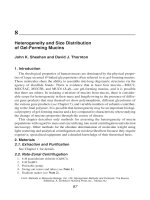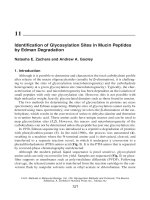Glycoprotein methods protocols - biotechnology 048-9-495-500.pdf
Bạn đang xem bản rút gọn của tài liệu. Xem và tải ngay bản đầy đủ của tài liệu tại đây (91.62 KB, 6 trang )
ELISA for Detection of Serum MUC1 Antibodies 495
495
41
Detection of Humoral Immune Responses to Mucins
Silvia von Mensdorff-Pouilly, Claus Vennegoor,
and Joseph Hilgers
1. Introduction
MUC1 is displaced and altered in malignancies originating in epithelial tissues. As
a consequence, a molecule with short carbohydrate side chains and exposed repetitive
epitopes on its peptide core is shed into the interstitial space surrounding a tumor and
gains access to the circulation (1–3), coming in contact with the immune system.
Humoral immune responses to MUC1 have been described in healthy subjects and in
patients with benign and malignant diseases (4–6).
Breast and ovarian carcinoma patients have antibodies reactive with the MUC1
molecule, bound into circulating immune complexes (7). Preliminary results suggest
that the presence of such immune complexes in breast cancer patients at the time of
diagnosis is related to a favorable disease outcome (8).
Unbound MUC1 IgG and IgM antibodies are present in the circulation of both
healthy subjects and breast cancer patients (9). Screening of a population of healthy
women with the bovine serum albumin (BSA)-conjugated peptide assay (described
under Subheading 2.1.) gave median IgG and IgM MUC1 antibody levels of optical
density units (OD) 0.580 (range 0.304–1.539) and OD 0.823 (range 0.227–1.589),
respectively. In pretreatment serum samples from breast cancer patients, the results
obtained were OD 0.651 (range 0.328–1.537) for IgG and OD 0.779 (range 0.178–
1.655) for IgM MUC1 antibodies. A benefit in survival was found in early stage breast
cancer patients with circulating MUC1 antibodies at first diagnosis (von Mensdorff-
Pouilly, et al., J. Clin. Oncol., in press), suggesting that active specific immunotherapy
of breast cancer patients with MUC1-derived (glyco)peptides after primary surgery, in
an adjuvant setting, might favorably influence the outcome of disease.
The enzyme-linked immunosorbent assays (ELISAs) described here are useful for
pretreatment screening of carcinoma patients for the presence of humoral immune
responses to MUC1 as well as for monitoring MUC1 antibody levels during MUC1
vaccine therapy. Other uses and applications include screening for suitable donors of
From:
Methods in Molecular Biology, Vol. 125: Glycoprotein Methods and Protocols: The Mucins
Edited by: A. Corfield © Humana Press Inc., Totowa, NJ
496 von Mensdorff-Pouilly et al.
MUC1-primed B-lymphocytes to obtain B-cell clones producing MUC1 antibodies
(10), creating human phage (anti)body libraries that may hold antibodies that recog-
nize MUC1 (11), monitoring antibody production in culture supernatant of MUC1-
primed B-lymphocytes (10), and epitope mapping of MUC1 or other antibodies (12).
2. Materials
2.1. BSA-Conjugated Peptide Assay (PEM.CIg)
1. Serum or plasma samples, fresh or frozen. Repeated freezing and thawing of the samples
(more than four times) should be avoided because it may alter results.
2. ELISA microtiter 96-well plates (Costar, Cambridge MA).
3. A synthetic 60mer peptide corresponding to three tandem repeats (TRs) of the MUC1
peptide core, i.e., NH
2
-(HGVTSAPDTRPAPGSTAPPA)
3
-COOH. The 60 mer peptide is
conjugated to BSA (Sigma, St. Louis, MO, RIA grade, cat. no. A-7888) using a 1-ethyl-3-
(3-dimethylaminopropyl) carbodiimide hydrochloride conjugation kit (Imject™ Immunogen
EDC Conjugation Kit for KLH and BSA, Pierce, Rockford, IL). After conjugation, deter-
mine the total protein content of the solution and prepare the BSA-conjugated peptide solu-
tion for coating the plates on the basis of the measured value. Store stock solution at –20°C.
4. 10 mM Sodium phosphate/0.15 M sodium chloride buffer, pH 7.0. To prepare 2 L of 5X
concentrated phosphate/salt buffer, dissolve 9.56 g of Na
2
HPO
4
, 4.5 g of Na
2
H
2
PO
4
·H
2
O
and 87.66 g of NaCl in demineralized water. Add demineralized water to 2 L. Experience
shows that the pH of the concentrated buffer is 6.6–6.7. No pH adjustments are needed:
after 5X dilution with demineralized water the pH of the phosphate/salt buffer should
measure 7.0.
5. Phosphate/salt buffer containing 0.5% BSA, to dilute the conjugate.
6. Blocking buffer (also for serum/plasma dilutions): phosphate/salt buffer containing 1%
BSA and 0.1% sodium azide.
7. Washing buffer-phosphate/salt buffer with 0.05% Tween-20. Approximately 30 mL of
washing buffer are necessary per washing turn (480 mL/plate).
8. Horseradish peroxidase-labeled rabbit antihuman IgG and IgM, both from Dako A/S, Glostrup,
Denmark. Dilute the conjugate 1:10,000 in phosphate/salt buffer containing 0.5% BSA.
9. Substrate solution containing 0.06 mg/mL of tetramethylbenzidine (TMB) diluted in 0.1 M
sodium acetate/citric acid buffer solution, pH 4.0, and 0.03% hydrogen peroxide. Sub-
strate solution should be prepared immediately before use as required.
a. Stock solution TMB: 6 mg 3,3',5,5'-tetramethylbenzidine (Sigma, cat. no. T-2885) in
1 mL of dimethyl sulfoxide. Store in the dark at room temperature.
b. 0.1 M sodium-acetate/citric acid buffer, pH 4.0. This pH is reached with a solution
containing 0.0627 M sodium acetate and 0.0374 M citric acid.
c. 30% Hydrogen peroxide.
10. 1.6 N sulfuric acid.
2.2. Biotinylated Peptide Assay
1. Streptavidin (Sigma-Aldrich, Zwijndrecht, Netherlands). Store stock solution (4 mg/mL)
in 50-µL portions at –80°C. Streptavidin solution for coating the plates: 4 µg/mL of
streptavidin in 10 mM sodium phosphate/0.15 M sodium chloride, pH 7.0, containing
0.02% sodium azide.
2. A 60mer synthetic peptide corresponding to three TR of the MUC1 peptide core
biotinylated at the amino terminal end. Three alanines should be incorporated at the amino
ELISA for Detection of Serum MUC1 Antibodies 497
terminal end to account for the streptavidin pocket. The final sequence is biotin-AAA-
(HGVTSAPDTRPAPGSTAPPA)
3
-COOH. Stock solution peptide: 1mg/ml in phosphate-
buffered saline (PBS). Keep at –70°C.
3. All other materials as in Subheading 2.1.
3. Methods
3.1. BSA-Conjugated Peptide Assay (PEM.CIg)
1. Apply 250 ng of BSA-conjugated peptide (see Note 1) diluted in 75 µL of phosphate/salt
buffer per well and 75 µL of 1% BSA solution per well to plates in duplicate alternate
rows. Seal the wells with plastic plate sealers and incubate overnight at room tempera-
ture. Plates can be stored, well sealed, for several months at –70°C.
2. Rinse the plates twice with demineralized water, shake the plates empty, and fill the wells
with demineralized water. Repeat once.
3. Fill the wells with 300 µL of blocking buffer, seal the plates, and incubate overnight at
4°C (or 3 h at 37°C).
4. Wash twice with washing buffer, shake the plates empty, and fill the wells with 300 µL of
washing buffer per well. After the last wash leave the washing buffer in the wells until
immediately before applying serum dilutions, because the wells should be left dry for
only the shortest time possible.
5. Shake the plates empty, one by one, immediately before applying serum. Apply 75 µL of
previously diluted human serum per well (see Note 2). Dilute human serum samples 1:100
(for IgG determinations) or 1:500 (for IgM determinations) in blocking buffer. Apply
each serum sample in duplicate, i.e., fill two wells coated with peptide and two wells
coated with BSA (see Notes 3–6). In each plate, fill one duplicate set of wells with block-
ing buffer only. Seal the plates and incubate overnight at 4°C.
6. Wash seven times with washing buffer: after the last wash leave the washing buffer in
wells until ready to fill with conjugate. Shake the plates empty, one by one, and dry upper
and underside of plates with clean tissue carefully before applying conjugate.
7. Drop into each well 75 µL of horseradish peroxidase-conjugated antihuman IgG (or anti-
human IgM) diluted 1:10,000 in 0.5% BSA solution. Avoid touching the bottoms and
sides of wells. Seal the plates. Incubate for 60 min at room temperature. Keep a small
amount of conjugate to test the substrate solution before you apply it. At equal amounts,
the mixture should immediately become an intense blue colour.
8. Wash seven times with washing buffer and rinse the plates once with demineralized water,
proceeding as in step 6.
9. Drop 75 µL of substrate solution into each well, avoid touching the bottoms and sides of wells.
Incubate for 60 min in the dark at room temperature. Positive wells will color blue. BSA-coated wells
should color pale blue, very faintly; to see the color place the plate against a white background.
10. Add into each well 100 µL of 1.6 N sulfuric acid to stop the reaction. Blue will turn to yellow.
11. Measure the reaction at 450 nm in a microwell plate reader.
3.2. Biotinylated Peptide Assay
1. Apply 75 µL of streptavidin solution to each well, seal the plates, and incubate overnight
at 4°C. Plates can be stored, well sealed, for several months at -70 C.
2. Wash the wells three times with washing buffer, shake the plates empty, and fill the wells
with 300 µL of washing buffer per well. After the last wash leave the buffer in the wells.
3. Shake the wells until empty and fill with blocking buffer, 300 µL/well. Seal the plates and
incubate at room temperature for 60 min (or overnight at 4°C).
498 von Mensdorff-Pouilly et al.
Table 1
Examples of IgG and IgM Readings of Individual Wells
IgG Determinations
Sample 60mer 60mer BSA BSA OD
Blocking buffer 0.150 0.150 0.044 0.044 0.106
Standard 1:250 1.091 1.111 0.099 0.095 1.004
Standard 1:500 0.801 0.808 0.077 0.080 0.726
Standard 1:1000 0.539 0.534 0.065 0.070 0.469
Standard 1:2000 0.384 0.385 0.056 0.057 0.328
Low sample 0.322 0.333 0.062 0.059 0.267
Middle sample 0.913 0.949 0.060 0.087 0.858
High sample 1.735 1.783 0.098 0.110 1.655
IgM Determinations
Sample 60mer 60mer BSA BSA OD
Blocking buffer 0.216 0.215 0.046 0.047 0.169
Standard 1:250 1.417 1.422 0.073 0.073 1.347
Standard 1:500 1.244 1.244 0.064 0.062 1.181
Standard 1:1000 1.024 1.051 0.055 0.056 0.982
Standard 1:2000 0.785 0.811 0.053 0.053 0.745
Low sample 0.238 0.237 0.073 0.068 0.167
Middle sample 0.917 0.926 0.073 0.078 0.846
High sample 1.523 1.524 0.079 0.085 1.442
Figure 1.
ELISA for Detection of Serum MUC1 Antibodies 499
4. Wash the wells twice with washing buffer. After the last wash, leave the buffer in wells.
5. Aspirate the buffer from the wells and fill with 75 µL of biotinylated peptide solution,
diluted to a concentration of 1 µg/mL peptide in 1% BSA solution. Seal the plates and
incubate for 60 min at room temperature.
6. Wash the wells three times as described in step 2. Proceed further as in Subheading 2.2.,
steps 5–11.
4. Notes
1. A comparison of the two assay methods showed the BSA-conjugated peptide assay to be
more sensitive for the detection of human MUC1 antibodies in serum and plasma samples
than the one with biotin-conjugated peptide. The reason could be the more random pre-
sentation of the peptide when conjugated to BSA, in comparison to its more orderly pre-
sentation, which could lead to steric hinderance, in the streptavidin-biotin system. The
biotinylated peptide assay has been used with excellent results to detect and monitor the
production of MUC1 antibodies by MUC1-primed B-lymphocytes in culture.
2. In our experience, prediluted serum and plasma samples (1:20 in phosphate/salt buffer/0.1%
BSA/0.1% sodium azide) give reproducible results even after 2 to 3 mo of storage at 4°C.
3. Individual results are calculated as the mean difference between the readings in optical
density units in the two peptide-coated and the two BSA-coated wells. Table 1 illustrates
some results.
4. To standardize the assay, construct a four-point standard curve for each individual plate
by testing a positive serum sample in four consecutive dilutions. Ascribe an arbitrary
value of 1 to the highest serum dilution, and calculate the value of the samples tested
within each plate in relation to the standard curve by least-square regression analysis
(Fig. 1). Measurements that fall outside the standard curve should be retested at higher
dilutions.
5. The choice of standards should be a matter of careful consideration. Humanized mono-
clonal antibodies provide suitable standards for IgG determinations (Fig. 2) whereas
Figure 2.









